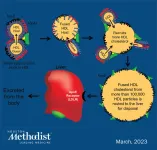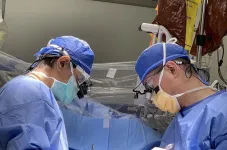(Press-News.org) Wildlife documentaries miss an opportunity to highlight the diversity of nature by focusing too much on mammals and birds, according to a new study.
In a new study published in People and Nature, researchers from the University of Cambridge have shown that while the production of wildlife documentaries has exploded over recent decades, they portray a biased view of the natural world around us.
Our natural world is under threat, from habitat and biodiversity loss, to high extinction rates. At the same time, there is a growing disconnect between people and nature, with children’s opportunities to experience the natural world diminishing.
Now more than ever the public are experiencing nature through technology, from documentaries to social media, which play a key role in shaping public attitudes and awareness as well as being an effective tool for social change.
However, nature documentaries have been accused of presenting a pristine view of the natural world while excluding the impacts of humans.
Lead author Kate Howlett, a PhD student in the Department of Zoology at the University of Cambridge, and fellow researchers analysed an online film database and collated a list of nature documentaries produced between 1918 and June 2021. A list of 945 documentaries was compiled and split into seven time periods, from each of which 15 random documentaries were chosen.
For each documentary, the researchers recorded every habitat, organism, and species featured and whether there was a conservation message mentioned.
Overall, the researchers found that wildlife documentaries provided a diverse picture of the natural world with an increasing focus on conversation. However, they overrepresented vertebrate species, potentially pushing public attention towards this group of animals and away from others.
Documentaries were seemingly biased towards vertebrates, which had 81% of mentions, with birds and mammals collectively making up more than half of mentions, while invertebrates only had 18% of mentions. This is despite vertebrates representing only 3.4% of known species compared to 75% for invertebrates. Plants had a consistently low representation across time periods.
Representations of insects, fish and reptiles showed large variations across the decades while representations of mammals and bird remained consistently high.
“There’s almost certainly a reason why we see more mammals and birds – if you want people to be engaged, you need animals that people are familiar with and already care about or they are not going to watch,” says Howlett.
“But this then risks leaving people with the impression that all of nature is fine. There is a balance to be had.”
A range of habitats were mentioned, with the most common being tropical forest and the least common being the deep ocean, and this did not change significantly over the time periods studied.
Moreover, conservation was mentioned in 16% of documentaries in total, but in almost half of documentaries in the current decade. No documentary before the 1980s contained a conversation message.
Increase in public awareness of conversation issues in the 21st century is clear, with mentions reaching 47% in the 2020s.
Anthropogenic impacts – the human impact on nature – were mentioned in 22% of documentaries, but never before the 1970s, with overexploitation of animal populations coming top of the mentions.
“We’ve not had to think about how people are experiencing nature before because it has just been in everyone’s lives”, says Howlett. “It wasn’t a problem before but now more and more people live in towns, cities and urban spaces.”
Findings from the paper are consistent with recent studies that suggest conservation science has itself been focused more on vertebrates over the last three decades.
The researchers argue that documentary film makers should look to increase the range of species and habitats featured, which could potentially increase awareness of the importance of the range of ecosystems and support for their conservation, as well as an appreciation for nature.
“Film makers have scope to focus on urban wildlife and engage the public by showing them wildlife in their local area and potentially inspiring people to engage more actively with local biodiversity,” says Howlett.
“It is quite frightening to realise how inaccurate our own perception of the world is, and it is important that viewers are given an appropriate balance between education and entertainment as well as hope and solutions to conservation problems.”
The research was funded by the Natural Environment Research Council.
Reference
Howlett, K., Lee, H.-Y., Jaffé, A., Lewis, M., & Turner, E. C. (2023). Wildlife documentaries present a diverse, but biased, portrayal of the natural world. People and Nature, 00, 1–12. https://doi.org/10.1002/pan3.10431
END
Knowing your ants from your anteaters: are wildlife documentaries showing us the ‘real’ natural world?
2023-03-15
ELSE PRESS RELEASES FROM THIS DATE:
Propeller advance paves way for quiet, efficient electric aviation
2023-03-15
Electrification is seen as having an important role to play in the fossil-free aviation of tomorrow. But electric aviation is battling a trade-off dilemma: the more energy-efficient an electric aircraft is, the noisier it gets. Now, researchers at Chalmers University of Technology, Sweden, have developed a propeller design optimisation method that paves the way for quiet, efficient electric aviation.
In recent years, electrification has been described as having an important role in reducing emissions from future aviation. Due to the challenges posed by longer ranges, interest is chiefly focused on electric propeller planes covering shorter distances. Propellers connected to ...
People of color have been largely underrepresented among authors published in the American Journal of Archaeology
2023-03-14
A new demographic survey of authorship in the American Journal of Archaeology (AJA) reveals that people of color have been largely underrepresented among the scholars published in the journal. The results of the survey, which also found that authors who are the children of people without advanced degrees were also underrepresented in the journal’s pages, are published in the paper “Demographic Dynamics of Publishing in the American Journal of Archaeology.” The study was conducted ...
Common cold gives children immunity against COVID-19
2023-03-14
During the pandemic, medical doctors and researchers noticed that children and adolescents infected with COVID-19 became less ill than adults. A possible explanation for this is that children already had a prior level of immunity to COVID-19 provided by memory T cells generated by common colds.
After studying unique blood samples from children taken before the pandemic, researchers from Karolinska Institutet in Sweden have now identified memory T cells that react to cells infected with SARS-CoV-2, the virus that causes COVID-19.
Four coronaviruses cause common colds
A possible explanation for this immunity in children is that they already had colds caused by one of the four coronaviruses ...
Researchers discover way to reverse infertility by reducing HDL cholesterol
2023-03-14
Houston Methodist scientists reversed infertility in sterile mice by reducing high-circulating cholesterol with a bacterial protein, showing further evidence that links high cholesterol to female infertility. This is a promising development, with one in every five women of childbearing age in the U.S. unable to get pregnant after trying for a year.
“We are working with a protein, called serum opacity factor, with unique characteristics,” said Corina Rosales, Ph.D., assistant research professor of molecular biology in medicine with the Houston Methodist ...
UK HealthCare’s Transplant Center celebrates 500th lung transplant
2023-03-14
LEXINGTON, Ky. (March 14, 2023) — The lung transplant team at UK HealthCare’s Transplant Center recently celebrated a major milestone, performing the 500th lung transplant since the lung transplant program was founded in 1991.
“This is an impressive milestone, and our whole staff — physicians, surgeons, nurse practitioners, nurse coordinators, pharmacists, nutritionists, social workers, therapists and support staff — should be very proud of their success,” said Sravanthi Nandavaram, M.D., medical director of the Lung Transplant Program. ...
How neuroimaging can be better utilized to yield diagnostic information about individuals
2023-03-14
Since the development of functional magnetic resonance imaging in the 1990s, the reliance on neuroimaging has skyrocketed as researchers investigate how fMRI data from the brain at rest, and anatomical brain structure itself, can be used to predict individual traits, such as depression, cognitive decline, and brain disorders.
Brain imaging has the potential to reveal the neural underpinnings of many traits, from disorders like depression and chronic widespread pain to why one person has a better memory than another, and why some people’s memories are resilient as they age. But how reliable brain imaging is for detecting traits has been a subject of wide debate.
Prior research ...
NASA’s Webb Telescope captures rarely seen prelude to supernova
2023-03-14
The rare sight of a Wolf-Rayet star – among the most luminous, most massive, and most briefly detectable stars known – was one of the first observations made by NASA’s James Webb Space Telescope in June 2022. Webb shows the star, WR 124, in unprecedented detail with its powerful infrared instruments. The star is 15,000 light-years away in the constellation Sagittarius.
Massive stars race through their lifecycles, and only some of them go through a brief Wolf-Rayet phase before going supernova, making Webb’s detailed observations of this rare phase valuable to astronomers. Wolf-Rayet stars are in the process of casting off their outer layers, ...
Potential treatment target for drug-resistant epilepsy identified
2023-03-14
Researchers at Tufts University School of Medicine and colleagues have identified a small molecule that may help treat people with epilepsy whose condition has become resistant to the benzodiazepine drugs usually used in managing seizures. The research, conducted in laboratory cells and rodents, was published online March 7 in Cell Reports Medicine.
Uncontrolled epilepsy can lead to frequent and prolonged seizures lasting five minutes or more that can cause brain cell damage and even death. The condition affects an estimated 3.4 million people in the U.S. and millions more worldwide.
Epilepsy occurs ...
New model provides improved air-quality predictions in fire-prone areas
2023-03-14
UNIVERSITY PARK, Pa. — Globally, wildfires are becoming more frequent and destructive, generating a significant amount of smoke that can be transported thousands of miles, driving the need for more accurate air pollution forecasts. A team of Penn State researchers developed a deep learning model that provides improved predictions of air quality in wildfire-prone areas and can differentiate between wildfires and non-wildfires.
“As climate change continues to cause ecological changes and challenges, it is likely that wildfire ...
New study finds early warning signs prior to 2002 Antarctic ice shelf collapse
2023-03-14
UNIVERSITY PARK, Pa. — In 2002, an area of ice about the size of Rhode Island dramatically broke away from Antarctica as the Larsen B ice shelf collapsed. A new study of the conditions that led to the collapse may reveal warning signs to watch for future Antarctic ice shelf retreat, according to a Penn State-led team of scientists.
“The collapse of the Larsen B ice shelf is generally thought of as an independent event,” said Shujie Wang, assistant professor of geography at Penn State. “Our ...



